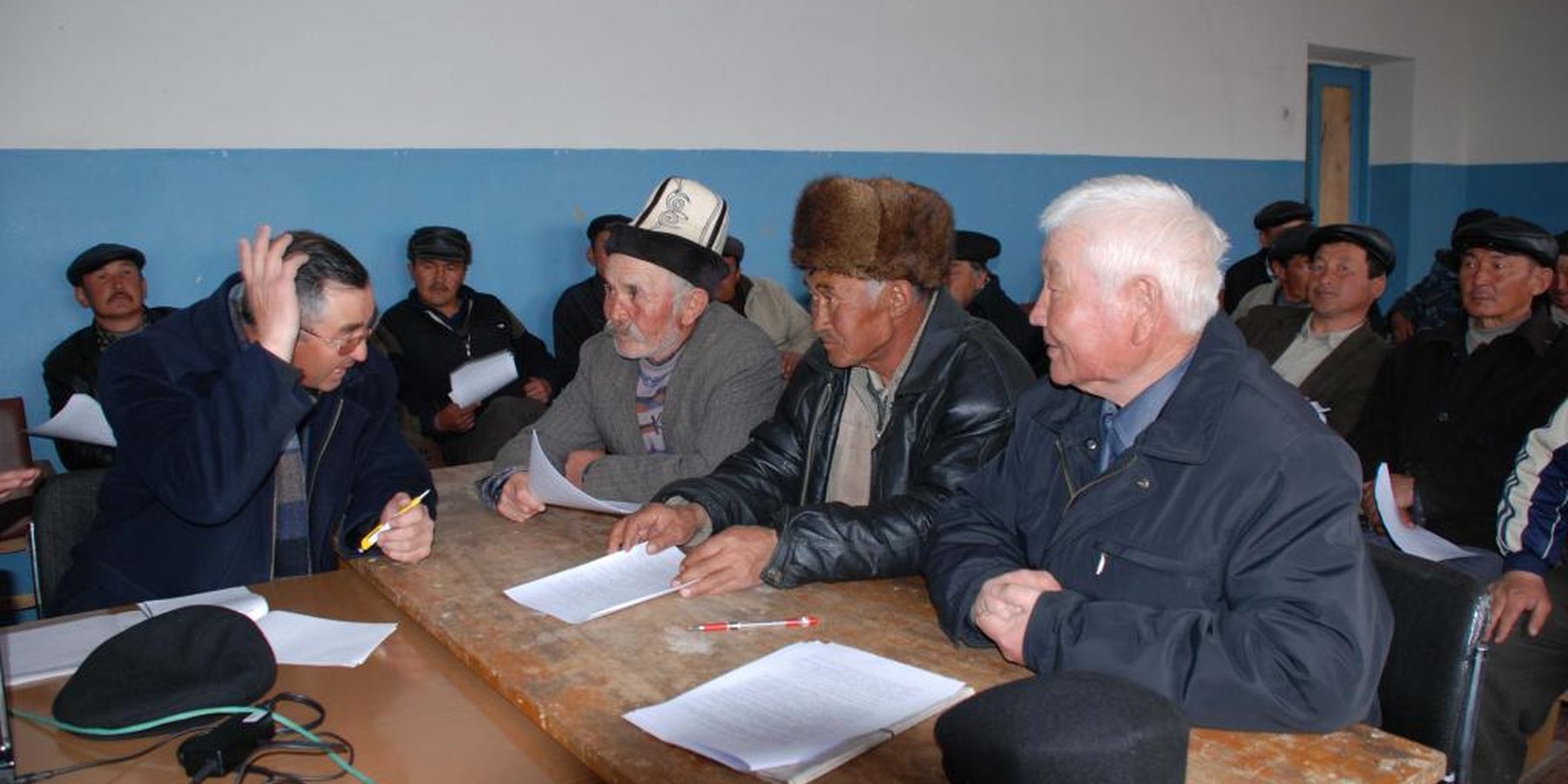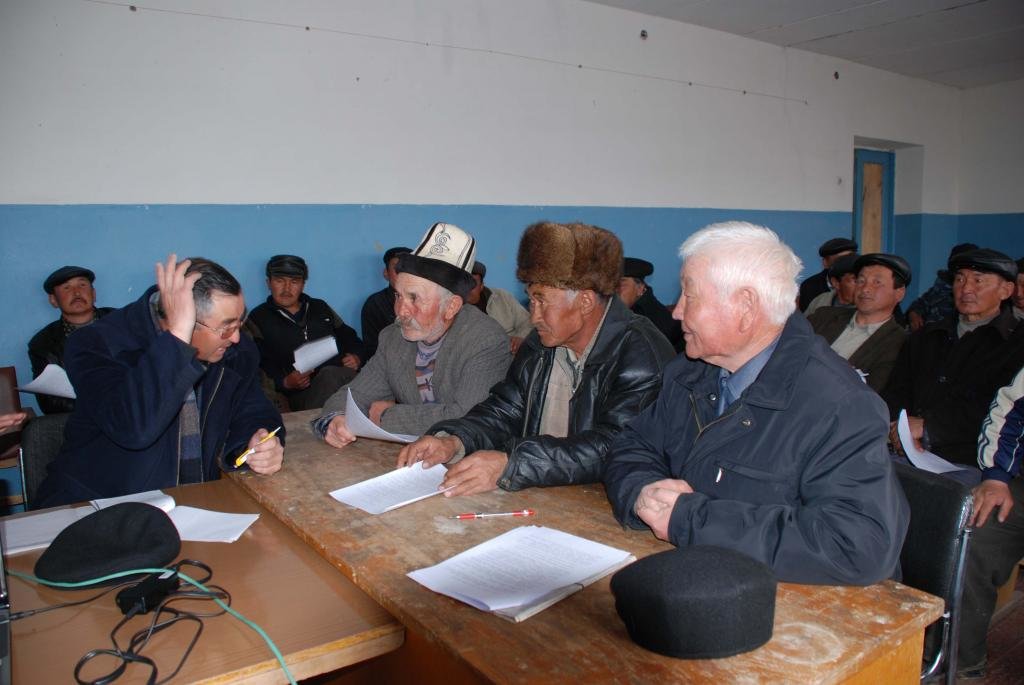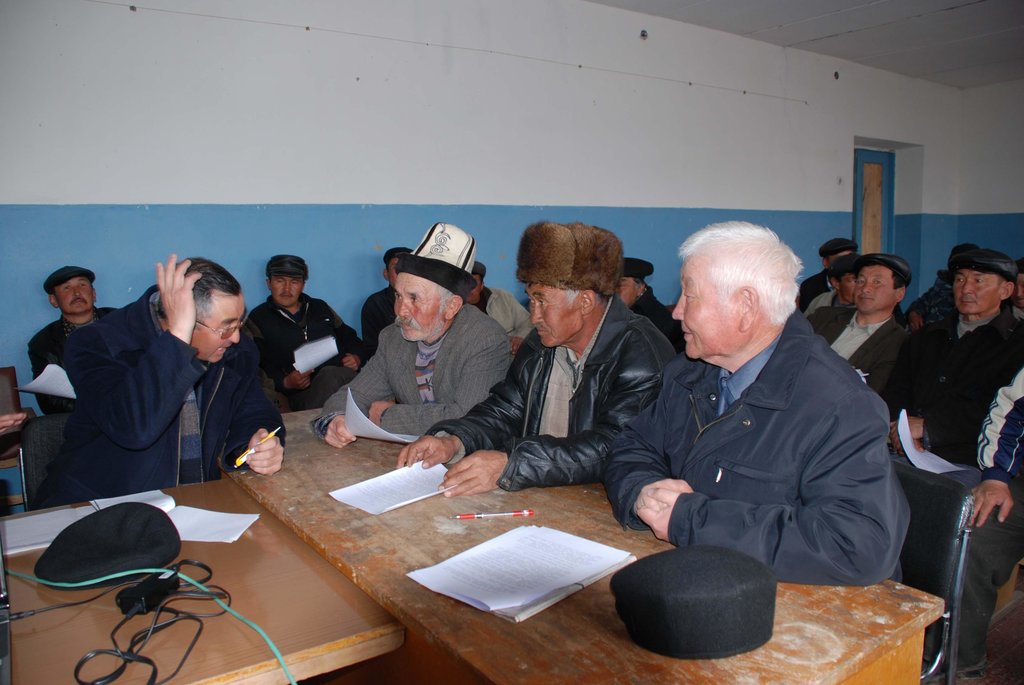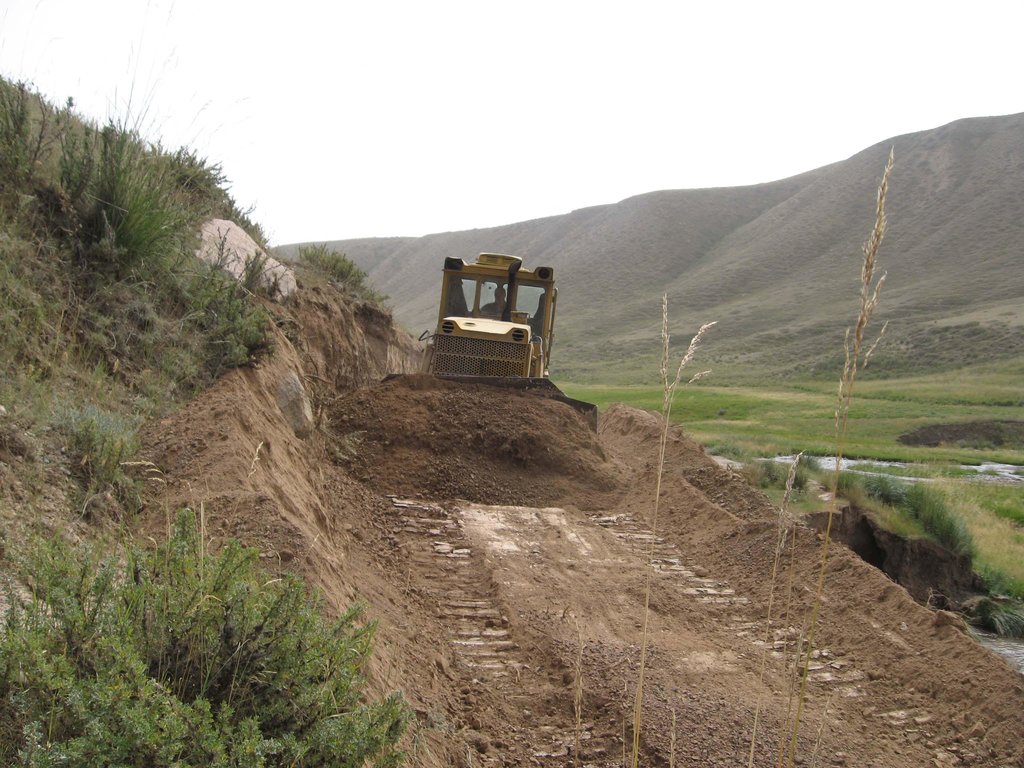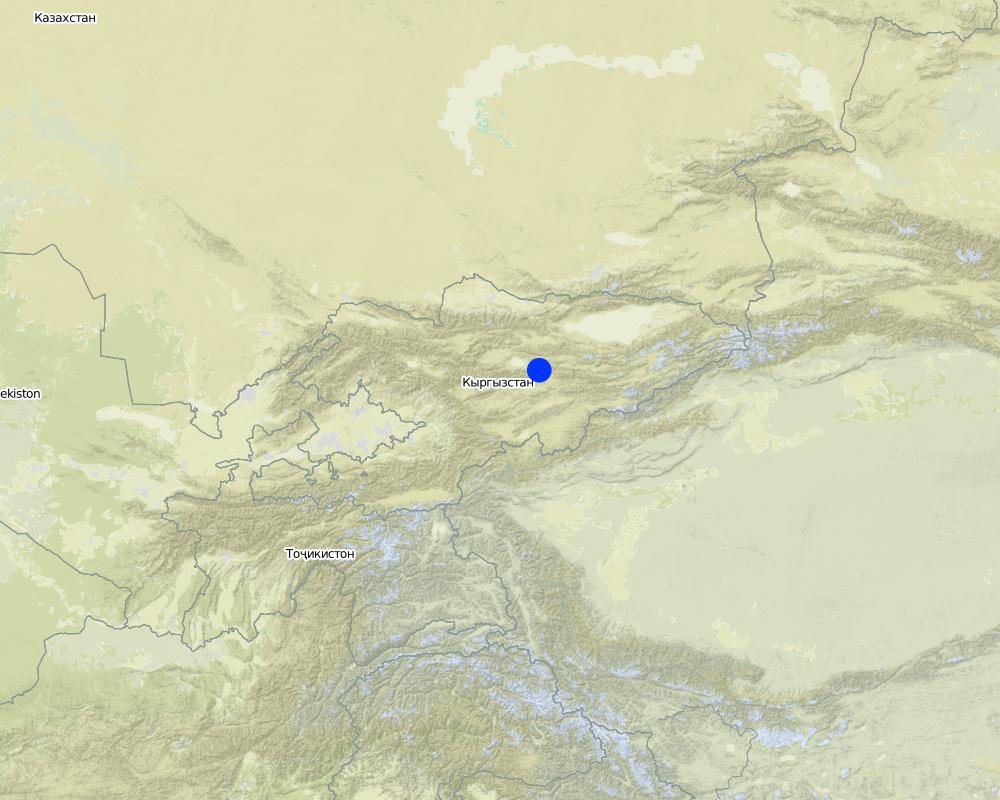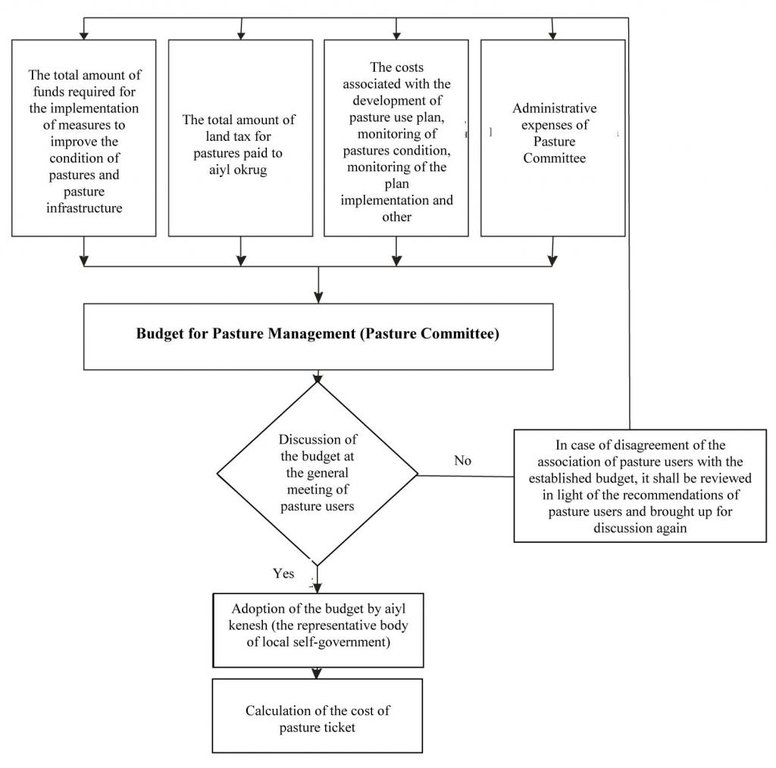Budget for Pasture Management [Kyrgyzstan]
- Creation:
- Update:
- Compiler: Azamat Isakov
- Editor: –
- Reviewers: Alexandra Gavilano, David Streiff
Central Asian Countries Initiative for Land Management (CACILM)
approaches_2463 - Kyrgyzstan
View sections
Expand all Collapse all1. General information
1.2 Contact details of resource persons and institutions involved in the assessment and documentation of the Approach
SLM specialist:
Wiedemann Christoph
christoph.wiedemann@cimonline.de
САМР Alatoo
3 Ufinskaya per.
SLM specialist:
Kozhomuratova Zhanyl
janyl@camp.elcat.kg
САМР Alatoo
3 Ufinskaya per.
Kyrgyzstan
Name of project which facilitated the documentation/ evaluation of the Approach (if relevant)
Central Asian Countries Initiative for Land Management (CACILM I)Name of the institution(s) which facilitated the documentation/ evaluation of the Approach (if relevant)
CAMP - Central Asian Mountain Partnership (CAMP - Central Asian Mountain Partnership) - KyrgyzstanName of the institution(s) which facilitated the documentation/ evaluation of the Approach (if relevant)
Deutsche Gesellschaft für Internationale Zusammenarbeit (GIZ) GmbH (GIZ) - Germany1.3 Conditions regarding the use of data documented through WOCAT
When were the data compiled (in the field)?
11/01/2013
The compiler and key resource person(s) accept the conditions regarding the use of data documented through WOCAT:
Yes
2. Description of the SLM Approach
2.1 Short description of the Approach
The budget for pasture management constitutes a necessary amount of funds for the implementation of pasture management activities planned for the year. These activities include the seasonal monitoring of pasture areas, the development of the grazing plan and monitoring of its implementation, activities to restore pasture infrastructure, measures to improve pasture condition, and the maintenance of the Pasture Committee. The means of income for the budget for pasture management are payments made for the use of pastures (in the frame of CACILM).
2.2 Detailed description of the Approach
Detailed description of the Approach:
Aims / objectives: Provision of financial sustainability to the Pasture Committees and implementation of Pasture Management Plans to reduce / prevent the degradation of pastures. For the realisation of the planned activities for pasture management it is necessary to have an annual budget plan managing the financial resources. The amounts of payment for the seasonal use of pastures is calculated based on this budget.
The budget for pasture management allows Pasture Committees to plan their activities based on their own financial resources, which,. Iin turn this, ensures the stability of Pasture Committees as independent institutions, and the implementation of measures to improve the condition of pastures and pasture infrastructure.
Stages of implementation: While developing the plan for pasture management the Pasture Committees identify the needs for rehabilitation of infrastructure (roads, bridges, watering points and others) and for improvement of pasture condition, as well as activities to promote the production of winter feed and measures for herd management. Identified needs are ranked by priority based on their relevance for the implementation of the plan for the use of pastures. The cost of the most relevant measures is calculated and the resulting amount of expenditures is included into the annual budget of the Pasture Committee. In addition, the budget includes the costs associated with the development of the plan for the use of pastures (development or purchase of pasture areas maps, determination of the numbers of livestock by type), the seasonal monitoring of pasture conditions to determine the capacity of each pasture area, the monitoring of the implementation of the plan for the use and management of pastures, as well as administrative costs of the Pasture Committee. The developed budget is being discussed at a general meeting of pasture users of the aiyl okrug. If pasture users feel that the budget is not feasible, the Pasture Committee must review the budget and reduce both the cost of measures to improve the condition of pastures and pasture infrastructure, as well as the administrative costs of the Pasture Committee. The corrected version of the budget is to be discussed and approved by the aiyl kenesh. Once the budget is approved, the value of the 'pasture ticket' is determined by dividing the total annual budget by the total livestock units of the aiyl okrug. Then, each owner of livestock must pay the costs for pasture use, in accordance with the number of cattle converted into equivalent units.
Role of stakeholders: Pasture Committees agree upon the developed budget with pasture users and aiyl kenesh (local parliament).
Other important information: This approach has been developed, tested, adapted and implemented by CAMP Alatoo PF in the framework of the project 'Sustainable Pasture Management in the Jergetal and Onarcha River Basins in Naryn District, Kyrgyzstan' 2008-2011 funded by the GIZ regional program “Sustainable Use of Natural Resources in Central Asia'.
2.3 Photos of the Approach
2.5 Country/ region/ locations where the Approach has been applied
Country:
Kyrgyzstan
Region/ State/ Province:
Naryn
Further specification of location:
Jergetal, Minbulak, Onarsha ail okrug
Comments:
The described approach is applicable to Pasture Committees of the Kyrgyz Republic, and could be the basis for the implementation of similar approach in the neighboring states
Map
×2.6 Dates of initiation and termination of the Approach
Indicate year of initiation:
2009
2.7 Type of Approach
- recent local initiative/ innovative
2.8 Main aims/ objectives of the Approach
The Approach focused mainly on other activities than SLM (to identify the needs for rehabilitation of pasture infrastructure and for improvement of pastures, to discuss the budget publicly, to approve the budget of Pasture Committee, pasture ticket)
Provision of financial sustainability to Pasture Committees and implementation of the pasture management plan.
The SLM Approach addressed the following problems: According to the Law 'On Pastures' of the KR the Pasture Committees hold the power to develop a budget for pasture management, to determine the amount of and collect the payment for the use of pastures (referred to as pasture ticket). The price for the right to use pasture areas is determined annually for each type of used pastures. Thereby, the price for a pasture ticket must not be lower than the basic rate of tax for the use of pastures. In determining the cost of pasture tickets, it is necessary to take into account the optimal load of pastures. The cost of the pasture ticket needs to be approved by the local kenesh and the pasture tickets have to be issued in accordance with the annual pasture use plan. The cost of a pasture ticket is determined on the basis of the Pasture Committee’s Budget for the planned year. It is calculated by the Pasture Committee in accordance with the pasture management plan. The needs of different Pasture Committees and respectively the amount of investment required may vary. Therefore, the costs of pasture tickets of different pasture committees differ. These funds are mainly directed to the improvement of pastures and pasture infrastructure.
2.9 Conditions enabling or hindering implementation of the Technology/ Technologies applied under the Approach
social/ cultural/ religious norms and values
- hindering
The population is not used to pay for the use of natural resources, in particular, for pastures.
Treatment through the SLM Approach: Awareness raising of pasture users.
availability/ access to financial resources and services
- hindering
Lack of available funds.
Treatment through the SLM Approach: Contributing to the reduction of poverty through the development of income-generating activities.
institutional setting
- hindering
Pasture Committee has not yet managed to win the trust of the local population.
Treatment through the SLM Approach: Increase the potential of Pasture Committees and pasture users, firstly, to fulfil all their functions and secondly, to monitor their actions, including the implementation of the budget.
legal framework (land tenure, land and water use rights)
- enabling
The existing land ownership, land use rights / water rights greatly helped the approach implementation: This approach is fully consistent with the current legislation of Kyrgyzstan on concerning the right of citizens to the sustainable use of pasture resources.
knowledge about SLM, access to technical support
- hindering
Low potential of accountants of Pasture Committees at the local level.
Treatment through the SLM Approach: Training members of Pasture Committees, developing the skills of accountants.
other
- hindering
Lack of financial documents, receipts for expenditures in rural areas to maintain accounting.
Treatment through the SLM Approach: Conduct short-term training courses based on local vocational schools.
3. Participation and roles of stakeholders involved
3.1 Stakeholders involved in the Approach and their roles
- local land users/ local communities
Members of the Pasture Committees are mostly men
A great difference between the participation of women and men is not the result of gender discrimination. Historically, men are responsible for the livestock and related activities in the family. However, if desired, women can participate in this process as well as men
Members of the Pasture Committee represent all segments of the population (small, medium and large farmers, representatives of clans; villages that make up the aiyl okrug, etc.).
Pasture users participate in the discussion and adoption of the budget for pasture management.
Members of pasture committees are developing the budget for pasture management.
- community-based organizations
Pasture Committees use this approach in practice.
- SLM specialists/ agricultural advisers
- NGO
The approach was tested by CAMP Alatoo Public Foundation.
- national government (planners, decision-makers)
Pasture Department
Local aiyl keneshes approve the budget for pasture management.
3.2 Involvement of local land users/ local communities in the different phases of the Approach
| Involvement of local land users/ local communities | Specify who was involved and describe activities | |
|---|---|---|
| initiation/ motivation | interactive | Seminars to raise awareness of pasture users, round tables, meetings with experts. |
| planning | interactive | Planning of the approach was carried out with the active participation of members of the Pasture Committee and the community. |
| implementation | interactive | Pasture committees develop budget. |
| monitoring/ evaluation | self-mobilization | Pasture users have the right to control the use of the budget funds by the Pasture Committee. The Pasture Committee reports on the use of the funds at the annual meeting of the Association of pasture users. |
| Research | none |
3.3 Flow chart (if available)
Description:
A chart showing the development of the Pasture Committee Budget and arrangements for its approval
Author:
Azamat Isakov (3, Uphimskiy pereulok Bishkek)
3.4 Decision-making on the selection of SLM Technology/ Technologies
Specify who decided on the selection of the Technology/ Technologies to be implemented:
- SLM specialists alone
Explain:
The approach has been developed, tested and adapted by the experts with the involvement of pasture users and adopted by a separate resolution of the Government of the Kyrgyz Republic.
Decisions on the method of implementing the SLM Technology were made by by politicians / leaders. This approach was developed at the local level, reviewed and approved by Pasture Department of the Ministry of Agriculture and Melioration, then submitted to the Government for consideration and adopted by it and then directed to relevant bodies to perform.
4. Technical support, capacity building, and knowledge management
4.1 Capacity building/ training
Was training provided to land users/ other stakeholders?
Yes
Specify who was trained:
- land users
- field staff/ advisers
If relevant, specify gender, age, status, ethnicity, etc.
Данный подход был включен в программу обучения Пастбищных комитетов по всей республике. Обучающиеся получают навыки по разработке бюджета Пастбищного комитета и расчета стоимости пастбищного билета.
Form of training:
- farmer-to-farmer
- public meetings
Form of training:
- Seminars
Subjects covered:
This approach has been included into the training program for Pasture Committees throughout the country. Trainees learn the skills to develop the budget of the Pasture Committee and to calculate the cost of the pasture ticket.
4.2 Advisory service
Do land users have access to an advisory service?
Yes
Specify whether advisory service is provided:
- on land users' fields
Describe/ comments:
Name of method used for advisory service: Budget for Pasture Management.; Key elements: Define the needs of the Pasture Committee., Develop the budget of the Pasture Committee. , Calculate the cost of the pasture ticket.; The pasture ticket is the economic lever to stimulate the reduction of the seasonal load on pastures, and it motivates the use of remote and unattractive pastures unused for various reasons.
Advisory service is quite adequate to ensure the continuation of land conservation activities; The extension system is quite adequate to ensure continuation of activities. The approach has been adopted by a government resolution and is being used by Pasture Committees throughout the country. The National Pasture Department and its regional offices are interested in and supports the collection of payment for pasture tickets across the country; they promote the out-scaling of best practices.
4.3 Institution strengthening (organizational development)
Have institutions been established or strengthened through the Approach?
- yes, a little
- technical support
Give further details:
All meetings and seminars were funded by the project.
4.4 Monitoring and evaluation
Is monitoring and evaluation part of the Approach?
Yes
Comments:
Technical aspects were regular monitored by project staff through measurements; indicators: % of implementation of the Pasture Committee budget
Socio-cultural aspects were regular monitored by land users through measurements; indicators: % of pasture tickets paid by pasture users.
Economic / production aspects were regular monitored by government, land users through observations; indicators: The total amount of funds raised.
Economic / production aspects were regular monitored by project staff through measurements; indicators: Across the country - all Pasture Committees.
Area treated aspects were regular monitored by project staff through measurements; indicators: % of pasture users who paid for their pasture ticket
No. of land users involved aspects were None monitored by project staff through measurements
There were no changes in the Approach as a result of monitoring and evaluation
There were no changes in the Technology as a result of monitoring and evaluation
4.5 Research
Was research part of the Approach?
No
5. Financing and external material support
5.1 Annual budget for the SLM component of the Approach
If precise annual budget is not known, indicate range:
- 10,000-100,000
Comments (e.g. main sources of funding/ major donors):
Approach costs were met by the following donors: international (The approach is implemented by means of GIZ projects.): 100.0%
5.2 Financial/ material support provided to land users
Did land users receive financial/ material support for implementing the Technology/ Technologies?
No
5.3 Subsidies for specific inputs (including labour)
- other
| Other (specify) | To which extent | Specify subsidies |
|---|---|---|
| Trainings and consultancies. | fully financed |
If labour by land users was a substantial input, was it:
- rewarded with other material support
Comments:
Labour of Pasture Committee members is paid out of the own budget.
Training and counseling was part of GIZ projects. Further introduction and out-scaling of the approach is carried out by pasture committees.
5.4 Credit
Was credit provided under the Approach for SLM activities?
No
6. Impact analysis and concluding statements
6.1 Impacts of the Approach
Did the Approach help land users to implement and maintain SLM Technologies?
- No
- Yes, little
- Yes, moderately
- Yes, greatly
The implementation of this approach makes it possible to improve the pasture infrastructure, thereby providing access to the unused pastures. Their development allowed to reduce the livestock load on the pastures close to the village, thereby reducing their degradation.
Did the Approach empower socially and economically disadvantaged groups?
- No
- Yes, little
- Yes, moderately
- Yes, greatly
All population strata use rehabilited pasture infrastructure to the same extent. Large families have the opportunity to increase their income in the summer through the sale of meat and dairy products;.Connection with the village has become easier, as repaired roads and bridges make it possible to use vehicles.
Did the Approach improve issues of land tenure/ user rights that hindered implementation of SLM Technologies?
- No
- Yes, little
- Yes, moderately
- Yes, greatly
). During the winter season the price of the pasture ticket remains very high, which motivates the pasture users to regulate the quantity of their livestock according to the to the season of the year. The awareness about it is currently reaching the pasture users, and according practical responses are expected to take place soon. There are successful examples, where unused and neglected pasture areas could be included into the pasture rotation scheme. The awareness about the increase in pasture productivity through their sustainable use is starting to appear.
Did other land users / projects adopt the Approach?
- No
- Yes, little
- Yes, moderately
- Yes, greatly
The World Bank project - 'Agricultural Investments and Services', component 'Pasture Management': The project developed a guidebook for Pasture Committees on preparing Pasture Management Plans, where this approach is used for the calculation of the cost of pasture tickets. The approach is used by 454 Pasture Committees throughout Kyrgyzstan.
Did the Approach lead to improved livelihoods / human well-being?
- No
- Yes, little
- Yes, moderately
- Yes, greatly
Restoration of damaged pasture infrastructure has allowed to better use remote pastures, which, of course, affects the welfare of the local community in the form of increased income due to weight gain of cattle and the opportunity to sell dairy products in the summer.
Did the Approach help to alleviate poverty?
- No
- Yes, little
- Yes, moderately
- Yes, greatly
As a result of increased incomes through the sale of livestock products
6.2 Main motivation of land users to implement SLM
- increased profit(ability), improved cost-benefit-ratio
The budget for pasture management allows Pasture Committees to effectively fulfil their functions.
- rules and regulations (fines)/ enforcement
The Law requires the development of the budget for pasture management.
- prestige, social pressure/ social cohesion
Increased equality of among pasture users is ensured
- environmental consciousness
Increase in pasture productivity.
- Экологическое сознание, здоровье
Увеличение продуктивности пастбищ
- well-being and livelihoods improvement
Increase in household income.
6.3 Sustainability of Approach activities
Can the land users sustain what has been implemented through the Approach (without external support)?
- yes
If yes, describe how:
Pasture Committees exist in the Kyrgyz Republic since 2009. They are designed to improve the condition of pastures and pasture infrastructure through the payments of pasture users. The implementation of these payments is based on the development of the budget for pasture management.
6.4 Strengths/ advantages of the Approach
| Strengths/ advantages/ opportunities in the land user’s view |
|---|
| A steady funding source for the activities for improving pasture condition and infrastructure becomes available. The budget is independent from the state subsidies (How to sustain/ enhance this strength: Possibility for further development of financial mechanisms of payment for the use of pasture resources by other users, such as hunters, gatherers of herbs, travel agencies, etc.) |
| Strengths/ advantages/ opportunities in the compiler’s or other key resource person’s view |
|---|
| Participation of local communities in decision-making on the budget of the Pasture Committee, as well as in the calculation of the cost of the pasture ticket for each aiyl okrug based on the number of livestock and the area of all types of pastures and their productivity (How to sustain/ enhance this strength: Increasing awareness of pasture users about the need to pay for the pasture ticket, to develop a budget for the Pasture Committee, as well as about their rights and responsibilities to control the development and execution of the budget. Dissemination of best practices and exchange of experiences will contribute to a successful and meaningful implementation of this approach) |
6.5 Weaknesses/ disadvantages of the Approach and ways of overcoming them
| Weaknesses/ disadvantages/ risks in the land user’s view | How can they be overcome? |
|---|---|
| The local population is not used to pay for the use of natural resources. | Raise awareness of the local population. It takes time for pasture users to get used to this type of payment |
| Weaknesses/ disadvantages/ risks in the compiler’s or other key resource person’s view | How can they be overcome? |
|---|---|
| Pasture Committees use a standard cost for the pasture ticket, regardless of the seasonal features. | Raise awareness among the pasture users and increase the potential of the Pasture Committees |
7. References and links
7.1 Methods/ sources of information
- field visits, field surveys
- interviews with land users
7.2 References to available publications
Title, author, year, ISBN:
Busler S. «Community Pasture Management in Kyrgyzstan», Bishkek, 2011
Available from where? Costs?
САМР Alatoo PF
Title, author, year, ISBN:
Annual reports of САМР Alatoo for 2009, 2010, 2011
Available from where? Costs?
САМР Alatoo PF
7.3 Links to relevant information which is available online
Title/ description:
Law of the Kyrgyz Republic «On Pastures» dated 26 January 2009 No.30
URL:
www.toktom.kg
Links and modules
Expand all Collapse allLinks
No links
Modules
No modules


